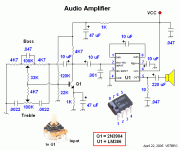I'm thinking about making my first DIY amplifier. It seems like the simplest way to start would be with an LM386 style. However, I wondered how many watts my speaker needs to be if I'm using a 9V power source? Thanks for helping a novice.
With a 9V supply I don't think that chip can produce 1 watt into an 8 ohm load - and that would be an overdriven, clipped, squarewave signal. Get the Data Sheet at < http://www.ti.com/lit/ds/symlink/lm386.pdf > and look at the graphs on the bottom of pg 4 to get an idea of what it can do under reasonable operating conditions.
Dale
Dale
A popular and quality chip might be an LM3886. You'll find a lot of info on it if you do a Google search. There are some kits you can by that use the 3886, and kits that use other chips.
Mike
Mike
I think the lm386 is directed to headphone driving, where typical sensitivities are around 90dB to 100dB/mW. That is about 10000times more sensitive than a domestic speaker.
Here are a few chip amps tested at Vs of 9v (regulated) maximum power before clipping.
*Don't use the LM386 with 4 ohm loads.
An externally hosted image should be here but it was not working when we last tested it.
*Don't use the LM386 with 4 ohm loads.
Mini Compound Amplifier Using the LM386 Chip Amp
Brgds
Hello AndrewT. I hope that you are well. I hope to bring your attention to the thread in the Pass Labs Forum which is entitled " Compound Power Amplifiers". Please go to its post #33 for an application using LM386 as a model.I think the lm386 is directed to headphone driving, where typical sensitivities are around 90dB to 100dB/mW. That is about 10000times more sensitive than a domestic speaker.
Brgds
- Status
- Not open for further replies.
- Home
- Amplifiers
- Chip Amps
- LM386
